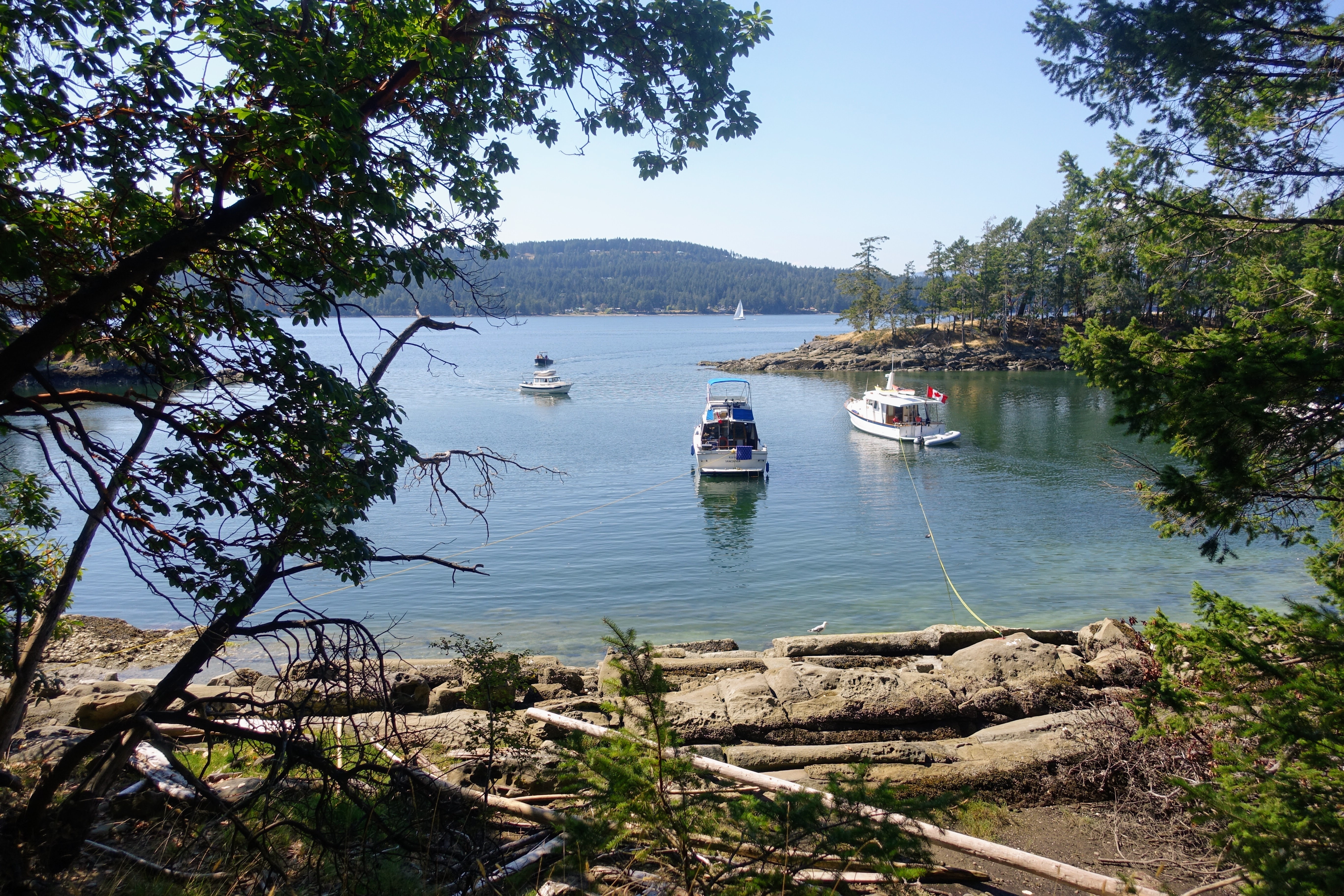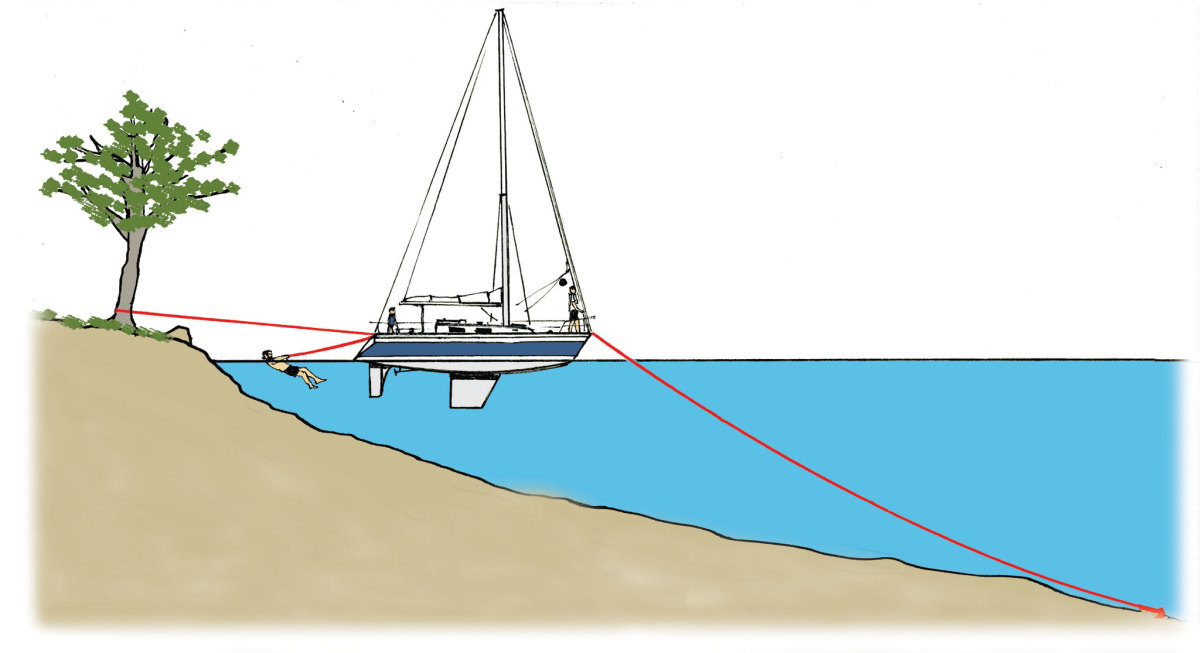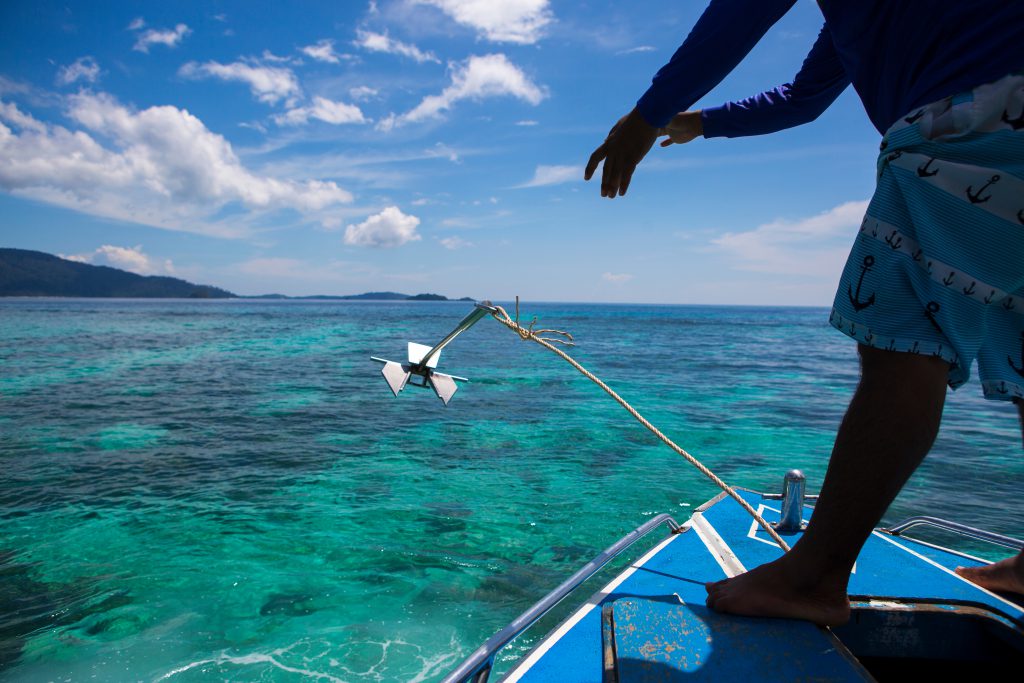Stern Anchors: Do You Need One?
March 8th, 2023 by team

by B.J. Porter (Contributing Editor)
Most places that you anchor, it’s best to anchor so you swing like everyone else. Mostly boats only use a single anchor, set from the bow. This way, everyone swings through all the wind directions together as it shifts and nothing goes bump in the night.
But there are times you don’t want to swing with the wind. Or maybe you want the boat fixed in one place. If there are, then a stern anchor may be right for you.
A few situations…
In our years out cruising, we came across a few situations where a stern anchor would have made a vast difference in our ability to anchor comfortably or safely. If you find yourself in where keeping your swing down is important, you’ll never regret having one.
Academy Bay, Puerto Ayora, the Galapagos – rolling and pitching

The administrative center of the Galapagos National Park, Santa Cruz is the most populous island in the Galapagos archipelago. It’s a must see stop in for any boat cruising through the islands and the center of many tours activities.
When we dropped anchor in Academy Bay, it was fairly flat and calm. The breeze we sailed in helped us set the anchor, and we felt secure and comfortable. A few hours later, the breeze dropped, and the swell started rolling in from the southeast. And every boat in the anchorage started to rock and roll.
The problem was the wind – for most of our stay in Puerto Ayora, it rarely matched the direction of the swell. So your boat was always facing willy-nilly all over the place, and often the swell hit the beam of the boat, causing a very uncomfortable rolling motion that made sleep nearly impossible and some of the crew nauseous in their bed.
A few well-prepared cruisers broke out stern anchors and set their boats to keep the bow into the swell. While it didn’t stop the swell, it kept the boats bobbing up and down instead of rolling violently from side to side. And this was a game changer for on-board comfort.
Penobscot and Casco Bay, Maine – anchoring in tight spots

Maine has some of the most amazing cruising grounds, and there are hundreds of small islets and coves you can drop a hook in and spend the night. There are big tidal swings, and some coves you shouldn’t enter except at low tide so you can see all the shoals and rocks so you don’t anchor on the bottom that won’t be there when the tide shifts!
A few islets and coves are tiny. They’re large enough to anchor a single boat in, but you might not want to swing around too much. Anchoring in a precise position and fixing your stern anchor is a good way to make sure that the cove is still big enough when the tide is out.
We ended up passing on a few beautiful, empty anchorages in Maine because we didn’t have a stern anchor so we didn’t think we could set the boat to swing freely and stay safe.
Tight anchorages everywhere

In many places there may be tiny spots with room for one boat to anchor near the edge of a channel, and fixing your boat so it doesn’t swing will keep the fishing boats and ferries from blasting their horns at you. A stern anchor can keep you from swinging out into the no-anchor zones and out of trouble when there’s not much space to anchor.
The trick is to make sure that if there are other boats packed in there with you, that they’re doing the same thing. If no one else is using a stern anchor to stay in bounds (or out of bounds!) then you won’t be able to, either.
Kedging
A final application of a stern anchor is for a kedge, if you’re trying to get your boat or a soft grounding or move it backwards. In that case, it’s the only anchor in use, but you’re moving it and re-setting it to get a grip on the bottom to pull the boat out of the mud.
It’s a useful safety technique, and many primary anchors are too bulky to work from a dinghy or by hand from the stern.
Stern Anchor Basics

A stern anchor is smaller and lighter than your primary anchor, as it isn’t holding the boat from dragging so much as keeping it from swinging. The loads are lower, so you don’t need as much holding power.
Selecting your stern anchor
When choosing a stern anchor, get something that is easy to stow. Flatter anchors like a Danforth or Fortress make excellent stern anchors. If you expect to use it frequently, or want to deploy one quickly, there are several permanent mounting brackets that make launch and stowing easy. Some of these work fine with anchors which don’t fold, as well.
You want a rope rode with a small amount of chain on the end. You do not want a heavy setup, since the stern anchor is usually set and retrieved by hand with a dinghy.
Setting a Stern Anchor

Setting a stern anchor isn’t complex, and most people do it with the dinghy in the water. Use radios to coordinate between the mother ship and the dinghy.
- Anchor the boat as you usually would with the bow anchor.
- Lower a dinghy.
- Estimate about how much rode you want on the stern anchor. Five or six to one scope isn’t a bad estimate.
- Prep the stern anchor and attach the rode to it.
- Attach the rode to a stern cleat at about the desired rode length.
- Put the stern anchor in the dinghy, and keep someone on the stern to pay out the rode.
- Slowly move the dinghy to the desired drop spot while paying the rode out and preventing tangles.
- When nearing the drop spot, put the big boat in reverse until the primary rode is snugged up and tight.
- Drop the stern anchor.
- Put the mother ship in neutral, and let the boat spring forward and set the stern hook.
- Check everything to make sure it’s stuck.
You can get a firmer set if you let a little extra bow rode out, then motor forward and pull it back in once you set the stern anchor.
Retrieving the stern anchor
Retrieving the anchor is a little different, as you need to slack the rode and break the anchor out of the bottom. You can do this from the dinghy, or you can ease the big boat anchor and back up to the stern anchor to break it out.
Is it for you?
It really depends on how you use your boat. If you rarely anchor out, the odds of you trying any kind of advanced anchoring in tight space are pretty low. But that doesn’t mean a kedge can’t save your bacon if you have a good anchor for it on board and you get stuck somewhere.
If any of the above scenarios sound familiar to you, or are things you come across frequently, that stern anchor may be a valuable addition to your boat.
- Posted in Blog, Boat Care, Boating Tips, Cruising, Fishing, iNavX, Navigation, News, Reviews, Sailing, Sailing Tips
- No Comments
- Tags: boat anchor, how to set an anchor, stern, stern anchors, who to set an anchor


Leave a Reply